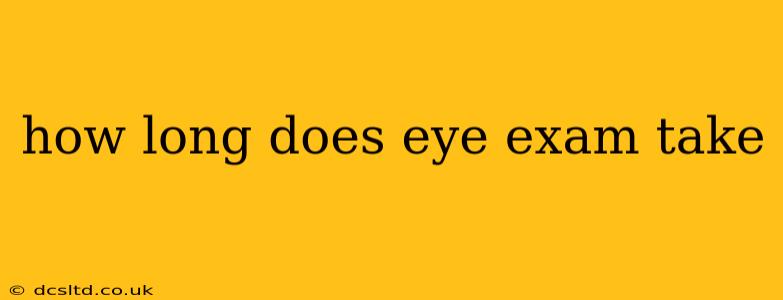How Long Does an Eye Exam Take?
The length of an eye exam can vary significantly depending on several factors. While a basic eye exam might be relatively quick, a comprehensive exam can take considerably longer. Let's explore the factors influencing the duration and what you can expect during your appointment.
What Factors Affect the Length of an Eye Exam?
Several factors contribute to the overall time commitment for an eye exam:
-
Type of Exam: A routine vision screening, focusing solely on refractive error (nearsightedness, farsightedness, astigmatism), will be much faster than a comprehensive dilated eye exam. A comprehensive exam includes a more thorough assessment of your overall eye health, looking for potential diseases and abnormalities.
-
Your Eye Health History: If you have a history of eye problems, or if the optometrist or ophthalmologist identifies potential issues during the exam, more time will be needed for further investigation and testing.
-
The Complexity of Any Issues Found: If your exam reveals abnormalities or potential problems, the doctor will need to spend more time diagnosing the issue and discussing treatment options.
-
The Optometrist's or Ophthalmologist's Schedule: While less directly related to the exam itself, a busy practice might allocate less time per patient than a less busy one.
What Happens During a Routine Eye Exam?
A typical routine eye exam might include:
- Visual Acuity Test: Checking your ability to see at various distances using an eye chart. This is the familiar "Snellen chart" test.
- Refraction: Determining your prescription for glasses or contact lenses. This usually involves using phoropters (those machines with lenses that click into place).
- Eye Muscle Balance Test: Assessing how well your eyes work together.
This type of exam typically lasts between 30 and 45 minutes.
What Happens During a Comprehensive Eye Exam?
A more comprehensive eye exam is a much more in-depth assessment of your overall eye health and might involve:
- All the steps of a routine exam: Visual acuity, refraction, and eye muscle balance tests.
- Pupil Dilation: Eye drops are used to widen your pupils, allowing for a better view of the back of the eye. This adds significant time to the exam.
- Slit-Lamp Examination: Using a special microscope, the doctor examines the structures of your eye in detail, including the cornea, iris, lens, and retina.
- Tonometry: Measuring the pressure inside your eye to check for glaucoma.
- Retinal Examination: A close examination of the retina using an ophthalmoscope or other imaging techniques to detect potential diseases.
- Visual Field Test: Assessing your peripheral vision.
A comprehensive dilated eye exam typically takes between 45 minutes to an hour or more.
How Long Does it Take to Get My Results?
The time it takes to receive your results depends on the complexity of the exam and whether any further testing or consultations are needed. For a routine exam, you typically receive your prescription immediately. However, for a comprehensive exam, you may need to schedule a follow-up appointment to discuss the results, especially if any further investigation is needed.
What if I Need Additional Testing?
If abnormalities are detected during your initial exam, additional tests might be necessary, significantly extending the overall time commitment. These might include:
- Optical Coherence Tomography (OCT): A non-invasive imaging technique that provides detailed images of the retina and optic nerve.
- Fluorescein Angiography: A test that uses a special dye injected into a vein to visualize blood vessels in the retina.
- Visual Field Testing (Perimetry): A test to measure your peripheral vision.
In summary, planning for at least an hour for a comprehensive eye exam is advisable. Always communicate any concerns or questions you have to your eye care professional to ensure the exam adequately addresses your needs. Remember, your eye health is crucial, so allow sufficient time for a thorough examination.
